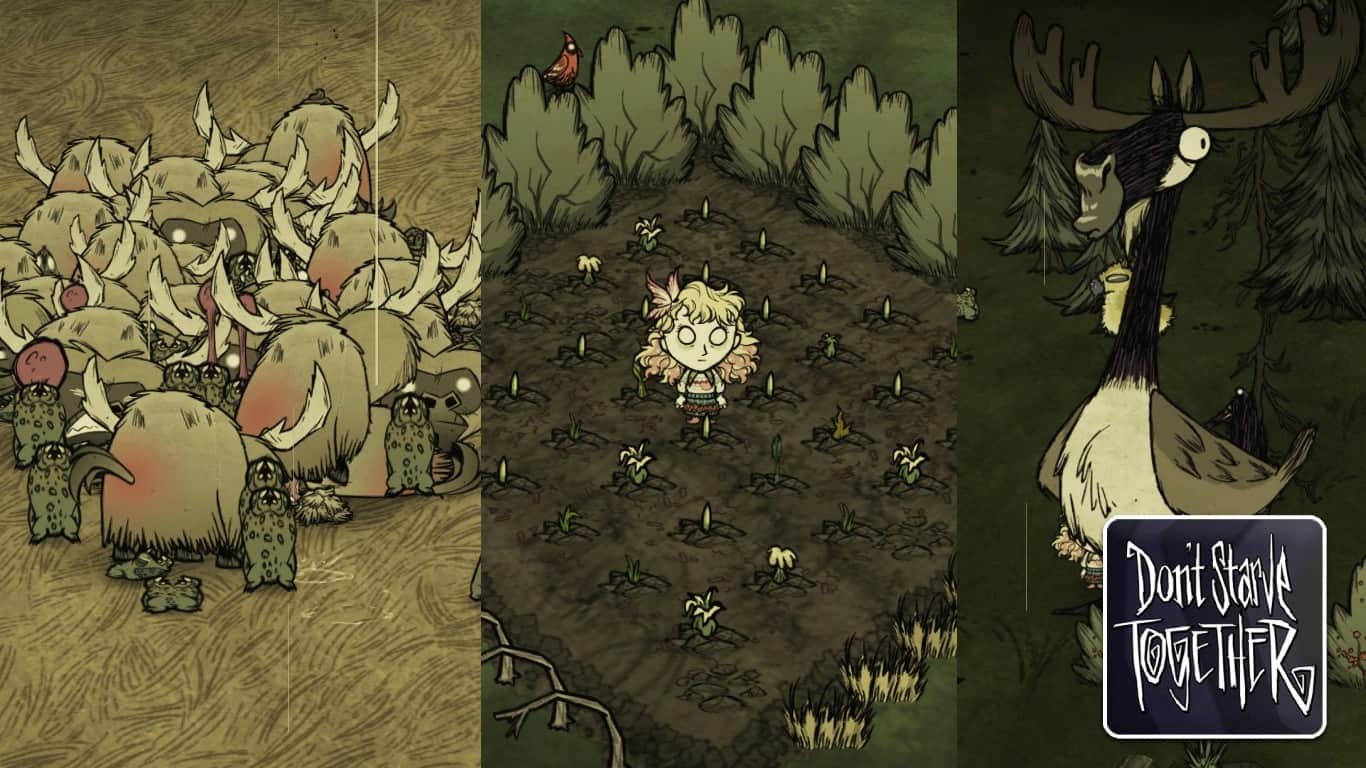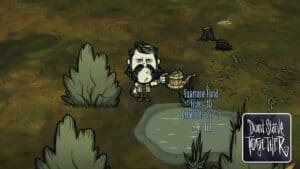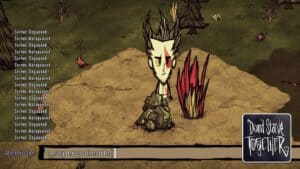Spring is one of the most annoying seasons in Don’t Starve Together, as it makes rain happen more frequently, causing wetness and low body temperature.
If you’re struggling to survive until the next season, this guide will show you exactly what to do in the Spring in Don’t Starve Together.
Recommended Read: When Does Summer and Winter Start and End in DST?
In Don’t Starve Together, the first thing to do in the Spring is to make an Umbrella (or Eyebrella) and a Rain Coat to avoid wetness. Then depending on your playstyle, you need to build lightning rods around the base, prepare a Thermal Stone for low temperatures, farm for resources and meats, and finally, beat the Moose/Goose.
Table of Contents
What to Do in the Spring in Don’t Starve Together
Although Spring is categorized as an easy season, many challenges and events in this wet season can destroy your base entirely.
By the time you reach Spring (around day 36), you must already have a decent base with essential resources, such as grass, twigs, logs, gold nuggets, pig skins, and silks.
When you’re ready, let’s see a list of things you should do in the Spring!
1. Make an Umbrella (or Eyebrella)
First and foremost, heavy rain happens frequently in the Spring, which increases the wetness bar quickly. This makes all items in your inventory wet, and they have a chance to slip from your hand when used.
In addition, the biggest problem from the wetness is the sanity reduction. With a high wetness bar and wet items, your sanity point is constantly reduced, summoning shadow creatures and making the game’s graphics look terrible.

To solve this problem, you need to use the Umbrella or Eyebrella. Moreover, Pretty Parasol is a cheap alternative. Below is the table for a comparison between these three items:
| Item | Materials | Wetness Reduction |
|---|---|---|
| Pretty Parasol | 4 Twigs, 3 Grass, 6 Petals | 50% |
| Umbrella | 6 Twigs, 1 Pig Skin, 2 Silks | 90% |
| Eyebrella | 15 Twigs, 4 Bone Shards, 1 Deerclops Eyeball | 100% |
You can also hide under the trees or stand next to a light source to reduce the wetness further.
Remember that all three methods above work well with each other. So, wearing one of the umbrellas, standing under a tree, and making a campfire is the best way to reduce wetness.
2. Make a Rain Coat
Rain Coat is one of the most versatile items in Don’t Starve Together since it gives you 100% wetness resistance, 60 cold resistance, and less chance of being hit by lightning strikes.
To make one, you’ll need 2 Tentacle Spots, 2 Ropes, and 2 Bone Shards.

Ropes can be crafted from grass, a common material. While Bone Shards can be obtained from bones with a hammer.
The Tentacle Spots are the most challenging material for this recipe because it only has a 20% chance of dropping from a Tentacle. And this monster isn’t easy to deal with at all!
3. Make a Lightning Rod
Because of the rain, lightning strikes also happen more frequently in the Spring. And with just a single lighting strike, your lovely base can turn into a massive pile of ash.

That said, building lightning rods simultaneously with your base is advisable, as you can plan the base layout and leave some small spaces for them.
Each lightning rod can protect an area of 10 by 10 tiles, so unless your base is massive, one lightning rod should do the trick. On the other hand, if you have multiple farms across the map, building a lightning rod in each location is recommended.
4. Prepare for Low Temperature
In addition to rain and lightning strikes, the temperature is quite low in the Spring, especially if you get wet.
So, bringing a Thermal Stone and pre-make a Campfire in the early days of Spring is advisable.
5. Farm Plants
Spring is the best season for farming plants and chopping trees, as the pickable plants (twigs, grass, berries, etc.) grow 33% faster, and all the trees grow 25% faster.
Moreover, crops also grow faster, and flowers can spawn naturally without any other conditions. So, you should stay home and farm for resources for later seasons if possible.

The recommended giant crops to farm in Spring are potato, carrot, corn, tomato, asparagus, eggplant, watermelon, dragonfruit, durian, garlic, onion, and pomegranate.
First, check out this post to learn how to create farmland and plant seeds. Then, when you have the above seeds, follow the farm layout here (Spring section) to farm the giant crops.
If you don’t have a specific crop to follow the layout above, you can use alternative crops as below:
- Potato for Eggplant
- Durian for Garlic
- Pomegranate for Onion
- Asparagus for Corn
Alternatively, you may want to dig all the saplings, grass tufts, and berry bushes before the Spring and make a small farm near the base. This way, you can easily harvest all the resources without traveling too much.
Remember to fertilize the berry bushes and grass tufts. Otherwise, they won’t grow.
6. Farm Meats
You already have a lot of plants and crops to eat, but meat is an indispensable ingredient to keep your meal diverse with nutrition.
In the Spring, rabbit holes are closed, the bees turn red and become hostile, while the Beefalos enter the mating phase and will also attack you if you come close. With these changes, getting meat and honey could be a pain.
Moreover, hunting for Koalefant is also more challenging because the animal track disappears faster in the Spring. The timer for each track reduces from 37.5 seconds to only 22.5 seconds.
With all the disadvantages like this, Spring also has good news.

Frog rain will occasionally happen, causing a lot of (and we mean a lot) frogs to drop from the sky. These frogs are hostile and will attack any creature in their sight.
That said, it may seem like frog rain is a huge problem. But if you can take advantage of it, you’ll have a lot of meat for the year!
If you’re near the base when the frog rain is happening, run to any one of the following locations:
- Beefalo field: frogs and mating beefalos will attack each other, leaving a mess with a lot of meat, frog legs, beefalo wools, and beefalo horns.
- Spider dens: Same as above, but you’ll get monster meat, silks, and frog legs instead.
- Moose/Goose nest: frogs from frog rain can easily kill this creature. So, if you want to tackle a boss fight without moving a finger, this is the way!
With all the meat collected from the fight, you can cook some meatballs to survive the day and put the rest in the Ice Boxes or hang them on the Drying Rack to make jerkies.
Remember that meat dries slower in the Spring, and the drying process is completely stopped if it’s raining.
7. Fight the Moose/Goose
Moose/Goose is the boss of Spring in Don’t Starve Together. But unlike other bosses in the game, you don’t have to fight it, and it won’t destroy your base either (except walls).
But if you want to get some meat, drumsticks, and especially Down Feathers, hunting this boss is another goal for Spring.
There are many ways to fight this boss, but the laziest way is just to tank it. You can take down this giant in minutes with some log armor, football helmets, and healing food.

If you’re a kiting veteran, soloing the Moose/Goose is a good option since it saves you many resources to make armor and healing food.
Like the Deerclops, you can attack the boss 3 times before running away to avoid its attack. However, the process is slightly different because the Moose/Goose honk after every third attack, making the players drop the equipped item in the hand slot.
Pro tip: Pay attention to the boss’s move. Before its honk attack, quickly unequip your weapon, wait for the honk, then equip the weapon again. This way, you don’t have to run away and pick up the weapon every time.
Besides, the Moose/Goose spawn with 5 Moslings. Those creatures are neutral at first, but when the Moose/Goose is down, they turn hostile and will attack you with a whirlwind move.
The tip here is to focus on only one Mosling. Follow it and wait until it’s dizzy, then simply stand still and attack. Next, repeat for the other four.
Since the Moslings can summon lightning strikes, wearing a Rain Coat is advisable.
If you’re struggling with the fight, remember that you can always use the frog rain or the beefalo herd to fight the boss.
That’s what to do in the Spring in Don’t Starve Together!
Have any suggestions for this guide? Let us know in the comments section below.




